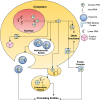Circular RNAs as Promising Biomarkers: A Mini-Review
- PMID: 27588005
- PMCID: PMC4988965
- DOI: 10.3389/fphys.2016.00355
Circular RNAs as Promising Biomarkers: A Mini-Review
Abstract
The interest in circular RNAs has resurfaced in the past few years. What was considered as "junk" for nearly two decades is now one of the most interesting molecules. Circular RNAs are non-coding RNAs that are formed by back-splicing events and have covalently closed loops with no poly-adenylated tails. The regulation of circular RNAs is distinctive and they are selectively abundant in different types of tissues. Based on the current knowledge of circular RNAs, these molecules have the potential to be the "next big thing" especially as biomarkers for different diseases. This mini-review attempts to concisely look at the biology of circular RNAs, the putative functional activities, the prevalence of circular RNAs, and the possible role of circular RNA as biomarkers for diagnosis or measuring drug response.
Keywords: biomarker; cancer; circular RNAs; targeted therapies.
Figures

References
-
- Bachmayr-Heyda A., Reiner A. T., Auer K., Sukhbaatar N., Aust S., Bachleitner-Hofmann T., et al. . (2015). Correlation of circular RNA abundance with proliferation – exemplified with colorectal and ovarian cancer, idiopathic lung fibrosis, and normal human tissues. Sci. Rep. 5:8057. 10.1038/srep08057 - DOI - PMC - PubMed
Publication types
LinkOut - more resources
Full Text Sources
Other Literature Sources
Miscellaneous

